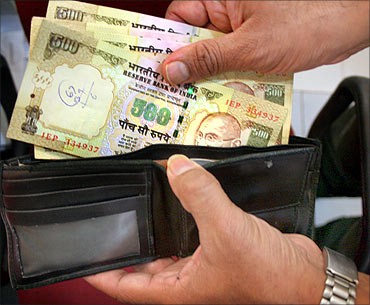 | « Back to article | Print this article |
This is how India can sustain its growth
Traditionally, the "festival season" in India, roughly six weeks preceding Deepavali, the equivalent of the pre-Christmas season in the West, is when the bulk of the annual sales of consumer goods happens.
The mood during the festive season is, therefore, an important determinant of annual sales.
So, what has the middle-class mood been like this festive season? Reports in the media suggest that the palpable "mood of negativism", which even Prime Minister Manmohan Singh referred to in his address to the National Development Council and which has gripped the national media and political conversations, has not blunted the edge of middle-class consumerism this festive season.
A fortnight ago, Agence France- Presse reported that "Indian festival season may see weak sales" (a report that China Daily dutifully carried!). But as Deepavali approaches, the media is full of stories of brisk sales and jobs in retail stores.
Click NEXT to read more...
This is how India can sustain its growth
Reporter Piyali Mandal of Business Standard quoted Vipul Prakash of the Indian Staffing Federation as saying, "In 2011 we have seen an up to 25 per cent increase in the hiring of temporary staff during the festivities. For certain sectors like retail, hiring has increased by 45 per cent compared to last year."
Temporary hiring is up because sales are up. Korean FMCG major Samsung alone has set for itself a sales target of Rs 2,500 crore (Rs 25 billion). The company launched a pre-Deepavali, 45-day "Samsung Smart Utsav" campaign on September 15, introducing a range of new products.
The auto sector, like other sectors where credit-financed consumption is high, has remained subdued but the two-wheeler segment is reporting robust sales.
If anything is dampening the festive mood, it is the rising cost of credit. So, unsurprisingly, credit-financed consumption is taking the hit. In the case of cash-financed consumption, as in gold, demand remains robust.
Click NEXT to read more...
This is how India can sustain its growth...
This may be as much an indicator of the worldwide mood of uncertainty gripping investors as it is of India's middle class buying more.
There are, however, limits to how much middle-class consumption can drive macroeconomic growth in India's investment-starved economy.
Paradoxically, in India even as consumption remains reasonably robust, growth in long-term investment has not yet reached a level that would sustain nine per cent growth.
The challenge for India's macroeconomic authorities is to boost investment without contributing to inflation and keep credit-financed consumption under check.
During the last upswing of India's growth cycle, from 2003 to 2008, a sustained increase in gross investment, with gross capital formation-to-gross domestic product ratio rising to an all- time high of over 38 per cent in 2007-08, drove the growth process.
Click NEXT to read more...
This is how India can sustain its growth
Since then, however, the investment rate in India has not picked up, while consumption has remained high, partly on account of the fiscal stimulus provided by the government in 2008-10.
The Indian growth process, as is well known, has been driven more by consumption than investment, unlike China's, and that in part explains persistent high inflation in recent months.
In the debate on growth versus inflation, the fact that remains unappreciated is that any dampening of consumption, as an anti-inflationary measure, has to be accompanied by an increase in investment so that aggregate demand is not adversely impacted.
The link between subdued consumption and investment plans can be broken if the government steps in.
Click NEXT to read more...
This is how India can sustain its growth
However, India's problem is that the government does not have the resources to step up the rate of investment.
Also, private sector investment has remained subdued for a variety of reasons, despite the uptick in consumption.
To be able to step up public investment, the government, both at the Centre and in the states, has to improve its fiscal health and its ability to implement public sector projects. On both counts, the governments have become weaker.
The newly floated option in the 11th Five Year Plan (2007-12), of pushing investment through the public-private-partnership (PPP) route, has fallen flat owing to concerns over crony capitalism and corruption.
Click NEXT to read more...
This is how India can sustain its growth
If PPPs come unstuck, if government finances and capabilities limit public investment, and if private investment remains subdued, how can the investment rate be pushed up? That remains the biggest policy challenge for India.
How can the Reserve Bank of India (RBI) help? One view is that it can help strengthen the microeconomic foundations of macroeconomic performance by going easy on interest rate hikes, thereby bringing some cheer to the markets.
A changed mood among investors in the short term may help boost investment prospects in the medium term. It is, however, not a convincing argument and the central bank may have good reason to ignore the idea.
Till now the RBI has, quite understandably, focused on preventing an over-heating of the economy from the consumption side and on bringing inflationary expectations down.
Click NEXT to read more...
This is how India can sustain its growth
The challenge going forward, of boosting the rate of investment, is one that governments have to tackle, and the central bank can do very little on its own.
Policy action that revives the "animal spirits" of enterprise and measures to fiscally empower the government to invest in the economy would obviously help.
The economy stands at a crossroads. The "mood of negativism" need not grip the economy as a whole and could well be a passing cloud. However, for the silver linings and the sun's rays to reappear, sustained political effort is required.
In 2008-09, in the aftermath of the transatlantic financial crisis, when the economy needed political leadership to sustain the growth momentum, it got it. There is no reason why this time it cannot get it. Last time they boosted consumption; this time they have to find ways to boost investment.







